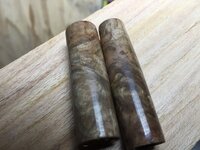Lacquer will give you the durability and the shine. Yet MOST turners will not allow the lacquer to harden first before polishing it. My woods sit for 45 days before polishing. Yes I do very few woods.
G'day,
The number of wood pens you make, has nothing to do with the amount of time, most chemical products that are made as a finish, require to set/cure properly, 98% of these products will require 14 days for the full curing process to complete, your 45 days seems a little excessive, the difference is that, some of those products are made to produce a hardened surface within a much shorter period of time, some a couple of days and other a couple of minutes.
Believe it or not, even CA will take days to cure properly, the thicker the coat the longer it will take however, this is the finish of choice among most penturners, just for the simple fact that, if allows for things to get "finished" rather quickly...!
Ideally, pen coated/finished with artificial products, should be left in store/resting for a couple of weeks before put for sale, handled, etc., this would avoid many nasty situations some penturners get into because, they went from making it to expose it (sale, handle, etc.) too quickly and "reactions" can occur that can be resolved or even minimized while in "resting"...!
Sure, making pens is so well received due to its fast start to finish stages, the quick gratification is infact, one of the reasons some people turn pens. I'm no exception, I do prefer a finish that gets the job done, fast, I like most of you, hate to wait particularly, being stuck waiting a few times through the making process of a pen, but not only...!
With this said, the day "they" invent a product that can do what the CA does, with all its various viscosities, being harmless to us and cost the average prices we pay for normal CA, I would one of the very interested persons, I use in average 10 litres of CA each year, 98% of that is the very thin CA (5cps) used to soak various of my made blanks, at certain stages of their making, there is nothing out there that I know of, that can replace this very thing and hot CA...!
Those pen barrels look to have a good shine and depth, I would suggest you to finish them on a buffing wheel, to remove the circular marks and deepen the finish even more...!
Cheers
George

